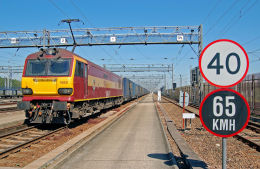Posted 7th May 2009 | 2 Comments
Freight trains could move on to HS1 by next year

Class 92 at Dollands More
CONTINENTAL-sized freight trains could be sharing the tracks of the London to Channel Tunnel HS1 route with high- speed passenger trains from early next year.
Detailed planning by freight operator DB Schenker and HS1 Ltd is at an early stage, and a number of operational options are under consideration.
The move comes 18 months after Eurostar launched its services to Paris and Brussels on the fully opened 68-mile HS1 route through Kent.
The route was designed with future freight traffic in mind and several freight loops were built into the system.
It is likely that most freight would run at night, when there is less demand from Eurostar, Southeastern domestic services and those of open access operators.
A possible terminal for the bigger ‘high cube’ Continental loading gauge containers, carrying freight of all kinds, already exists at Barking, east London.
An aspiration is for an ultimate freight train top speed of around 140 mph, which will be the maximum speed of Class 395 domestic services coming in later this year. However, that would require new locomotives.
When the service starts it is expected that the locos to be used – dual-voltage Brush Traction built Class 92s, introduced in the mid-90s – will run between 60mph and 80mph. Top speed of the 127-tonne locos is 87mph.
DB Schenker’s planning director Graham Smith said: “This initiative will allow full-size European rail freight vehicles to move between the UK and the rest of Europe. It will open up a massive market for cross-Channel rail freight, delivering major environmental and economic benefits.”
The freight breakthrough follows the signing of an agreement between HS1 Ltd and DB Schenker Rail (UK) Ltd, which involves modifications to the Class 92 electric locos. They will have to undergo software modifications to ensure they are compatible with HS1 signalling. The locos – the overall size of the fleet is 46 – will operate with cab signalling.
HS1 will lead the software development and ensure that the modifications required are available to all owners of Class 92s wanting to operate over HS1 infrastructure.
As well as the ‘Heads of Term’ co-operation, the two parties have also agreed outline terms for a track access agreement in anticipation of freight services over the high-speed route beginning in early 2010.
Paul Chapman, managing director of HS1, said: “This agreement is a major milestone, clearing the way for freight operation over HS1 infrastructure by DB Schenker and any other interested party able to utilise the Class 92 fleet.”
In his presentation at the Railtex exhibition in March, Eurostar chief executive Rich-ard Brown explained his view that the major benefits of high speed rail are to be gained through limited-stop passenger operation.
He said freight traffic could be better served by existing mixed traffic routes, to which it has ready access from ports, terminals and markets.
But, with HS1 having been designed for use by freight traffic as well as high-speed passenger trains, he is not surprised that progress is now being made towards that end.
“In terms of future high speed routes, however, I see no need to follow slavishly the design and concept of HS1,” he told Railnews.
Reader Comments:
Views expressed in submitted comments are that of the author, and not necessarily shared by Railnews.

Llion, Cardiff
I agree with all u are saying Rail freight is the way forward not road transport, Long live the railway, if this is the case the lorry drivers can drive around in their Gas guzzling truck for longer cos Fuel will last longer by using rail.
Kevin Street, Maidstone, England
With freight trains traveling at 60-80 mph along HS1 can reach London within 1 hour, is it logical to intercept freight trains at Ashford kent and bring these trains along domestic lines to Kent International Gateway?
Does DB Shenker Rail (UK) Ltd have an agreement with KIG?
We all want to see a reduction of HGV's on our roads and more freight carried by rail but intercepting freight trains in Kent before distribution makes no sense especially when KIG admit the HGV movements will increase by 3,800.
I would appreciate your opinion.
Regards
Kevin Street